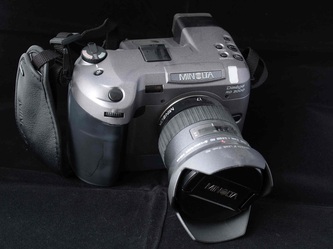Minolta RD 3000
The RD 3000 is Minolta's second digital SLR (first came the RD 175). It's quite a peculiar camera with its dual 1/2" (6.4x4.8mm) CCD. While the CCD sensors in the camera are considerably smaller than a fullframe sensor, the mirrors and prisms of the "reflex optics" used in the RD 3000's optical path serve to reduce the effective difference, producing a final crop factor of only 1.5x. Comparable to APS-C. This all sounds very nice, but comes at a terrible cost. Every lens, will have a maximum aperture of 6.7. So if you think you have equipped your camera with the nicely matching 3.5/17mm, forget it! It actually becomes a 6.7/26 mm on the RD 3000 (cropfactor included). Gee that's a bummer! Sounds a lot less compelling than 3.5/17mm, isn't it? (Of course you can still use it as a 3.5/17mm on the APS SLR's, which would become a 21 mm in APS-H).
Minolta announced the RD 3000 in 1999. In those days it was sold at a rather reasonable retail price of around € 4.000 body only. Compared to, for example, a Nikon D1 of those days, it was sold for only half the price.
Compared to todays standards the RD 3000 is terribly outdated. It's slow, especially if you shoot the TIFF format, it's extremely slow. It's heavy and bulky. Exposure is a bit unreliable, especially with flash. There's only ISO 200 and 800 to choose of. It eats batteries like there's no tomorrow (though you can use rechargeable AA's) and so forth . But it's not over until the final word: image quality is not that bad at all. Actually I made some fine pictures with this camera. Pictures I still like today.
Practical use today is none to zero.
Minolta announced the RD 3000 in 1999. In those days it was sold at a rather reasonable retail price of around € 4.000 body only. Compared to, for example, a Nikon D1 of those days, it was sold for only half the price.
Compared to todays standards the RD 3000 is terribly outdated. It's slow, especially if you shoot the TIFF format, it's extremely slow. It's heavy and bulky. Exposure is a bit unreliable, especially with flash. There's only ISO 200 and 800 to choose of. It eats batteries like there's no tomorrow (though you can use rechargeable AA's) and so forth . But it's not over until the final word: image quality is not that bad at all. Actually I made some fine pictures with this camera. Pictures I still like today.
Practical use today is none to zero.
| rd_3000_uk_hw.pdf | |
| File Size: | 1422 kb |
| File Type: | |



